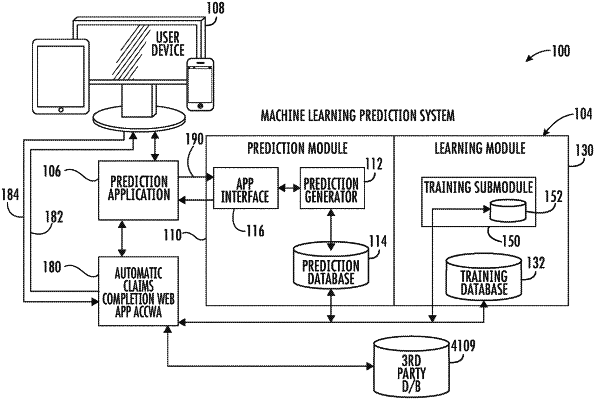| CPC G06Q 40/08 (2013.01) [G06F 17/18 (2013.01); G06N 20/00 (2019.01); G06N 5/02 (2013.01)] | 6 Claims |

|
1. A method executed within a computer network architecture with artificial intelligence and machine learning that includes a prediction module implemented by one or more processors, with a prediction generator and an updated database; a learning module implemented by the one or more processors, with a training submodule implemented by the one or more processors, in electronic communication with the prediction module and the updated database; a prediction application implemented by the one or more processors, in electronic communication with the prediction module; and an automatic claims completion web application ACCWA implemented by the one or more processors, with artificial intelligence and machine learning in electronic communication with the prediction application, the prediction module, the learning module, the updated database, and a user device, the method comprising:
executing operations with the ACCWA comprising:
receiving a user request for predictions of healthcare outcomes for pending incomplete individual healthcare clinical episodes,
collecting, automatically, incomplete data for healthcare insurance claims and healthcare costs for the pending incomplete healthcare episodes to date,
collecting, automatically, complete data for the healthcare insurance claims and healthcare costs for the pending incomplete healthcare episodes to date,
loading, automatically, the collected data into databases in the computer network architecture,
matching, automatically, the collected complete data for the healthcare insurance claims and healthcare costs for the pending incomplete healthcare episodes to date, with the collected incomplete data for healthcare insurance claims and healthcare costs for the pending incomplete healthcare episodes to date, for each identical pending incomplete healthcare episodes to date,
accessing, automatically, the prediction application to request a prediction of estimated final claims and cost data for healthcare insurance claims and healthcare costs for pending incomplete individual healthcare clinical episodes, on a claim type by claim type basis, wherein the prediction is based on predictions of individual healthcare outcomes, the collected incomplete data for the healthcare insurance claims and healthcare costs for the pending incomplete healthcare episodes to date, and the collected complete data for the healthcare insurance claims and healthcare costs for the pending incomplete healthcare episodes to date,
collecting, automatically, and load other incomplete data sets into databases in the computer network architecture,
receiving, automatically, from the prediction application the predicted estimated final claims and cost data for healthcare insurance claims and healthcare costs for pending incomplete individual healthcare clinical episodes, on the claim type of claim type basis,
generating, automatically, a report of the predicted estimated final claims and cost data for healthcare insurance claims and healthcare costs for pending incomplete individual healthcare clinical episodes, on the claim type by claim type basis, and
transmitting, automatically, the generated report to the user device; and
executing operations with the prediction application comprising:
receiving from the ACCWA a request for the prediction of estimated final claims and cost data for healthcare insurance claims and healthcare costs for pending incomplete individual healthcare clinical episodes, on the claim type by claim type basis,
access the prediction module and request it to fit a statistical model definition that regresses the collected complete data for the healthcare insurance claims and healthcare costs for the pending incomplete healthcare episodes to date, on characteristics of the collected incomplete data for the healthcare insurance claims and healthcare costs for the pending incomplete healthcare episodes to date,
obtain the statistical model definition and automatically apply the statistical model definition to the collected incomplete data for the healthcare insurance claims and healthcare costs for the pending incomplete healthcare episodes to date, to predict the estimated final claims and cost data for healthcare insurance claims and healthcare costs for pending incomplete individual healthcare clinical episodes, on the claim type of claim type basis, and
transmit the predicted estimated final claims and cost data for healthcare insurance claims and healthcare costs for pending incomplete individual healthcare clinical episodes, on the claim type of claim type basis, to the ACCWA,
wherein, the learning module is configured to:
receive a list of algorithm definitions and a dataset,
calibrate one or more algorithms for a plurality of the model types with the dataset, test the calibrated algorithms with a plurality of evaluation metrics,
store the calibrated algorithms and evaluation metrics in the predictive model library,
select an algorithm from the calibrated algorithms based on the evaluation metrics and store the selected algorithm in the prediction database,
update the training database with third party data, and user episode data, and
re-execute the calibrate, test, store, select and update steps automatically and continually, either periodically, occasionally, or with each user prediction request;
wherein, the prediction module is configured to:
receive a user prediction request for patient risk scoring, including episode data of an individual patient and a client model,
run the currently selected best algorithm corresponding to the user of the episode data, and generate patient risk scoring prediction output,
generate a patient risk scoring prediction report based on the algorithm output, wherein the patient risk scoring report identifies at least one possible medical treatment of an individual patient and an outcome probability associated with the at least one possible medical treatment, and
transmit the patient risk scoring prediction report to the user.
|